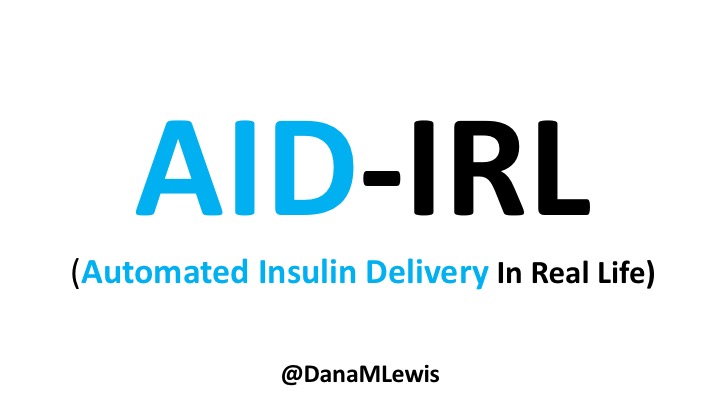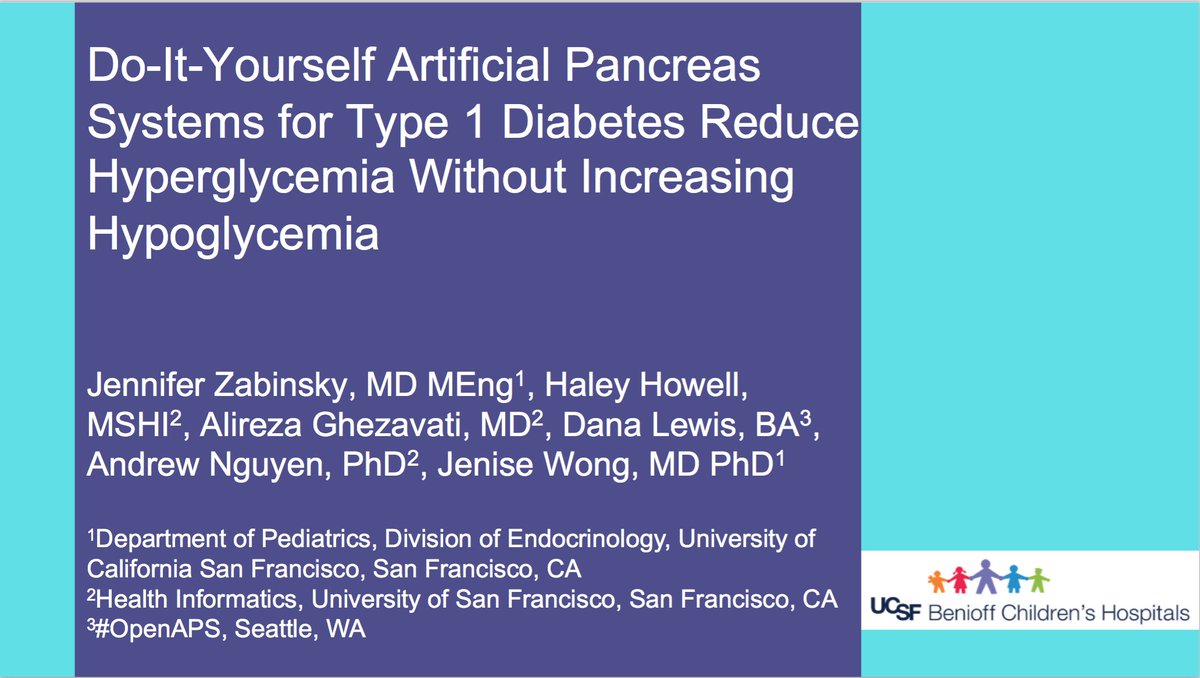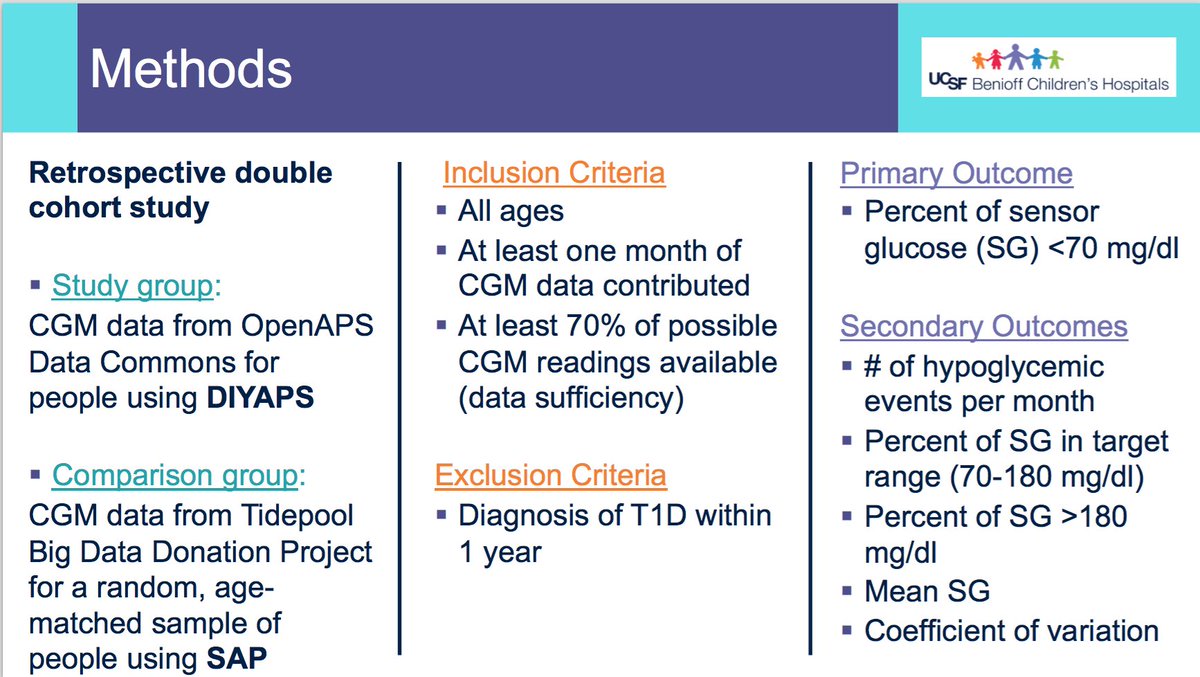At #DData2020 today, I got to present (virtually!) a study called “AID-IRL”, which was an opportunity to learn from several people using commercial automated insulin delivery systems in the real world.
Here’s more information about the study, and what I learned!
THREAD:
Here’s more information about the study, and what I learned!
THREAD:

1/ I did semi-structured phone interviews with 7 users of commercial AID systems in the last few months. The study was funded by @DiabetesMine. Study participants received $50 for their participation. #DData2020 

2/ I sought a mix of longer-time and newer AID users, using a mix of systems. Control-IQ (4) and 670G (2) users were interviewed; as well as (1) a CamAPS FX user since it was approved in the UK during the time of the study. #DData2020 

3/ Based on the interviews, I coded their feedback for each of the different themes of the study depending on whether they saw improvements (or did not have issues); had no changes but were satisfied, or neutral experiences; or saw negative impact/experience. #DData2020 

4/ For each participant, I reviewed their experience and what they were happy with or frustrated by. Here are some of the details for each participant. #DData2020
5/ A parent of a child using Control-IQ (off-label), with 30% increase in TIR with no increased hypoglycemia. They spend less time correcting than before; less time thinking about diabetes; and “get solid uninterrupted sleep for the first time since diagnosis”. #DData2020 

6/(cont) They wish they had remote bolusing, more system information available in remote monitoring on phones. They miss using the system during the 2 hour CGM warmup, and found the system dealt well with growth spurt hormones but not as well with underestimated meals. #DData2020 

7/ An adult male with T1D who previously used DIYAPS saw 5-10% decrease in TIR (but it’s on par with other participants’ TIR) with Control-IQ, and is very pleased by the all-in-one convenience of his commercial system. #DData2020 

8/ (cont) He misses autosensitivity (a short-term learning feature of how insulin needs may very from base settings) from DIYAPS and has stopped eating breakfast, since he found it couldn’t manage that well. He is doing more manual corrections than he was before. #DData2020 

9/ An adult female with LADA started, stopped, and started using Control-IQ, getting same TIR that she had before on Basal-IQ. It took artificially inflating settings to achieve these similar results. She likes peace of mind to sleep while system prevents hypoglycemia. #DData2020 

10/(cont) She is frustrated by ‘too high’ target; not having low prevention if she disables Control-IQ; and how much she had to inflate settings to achieve her outcomes. It's hard to know how much insulin system gives each hour (she still produces some of own insulin). #DData2020 

11/ An adult female with T1D who frequently has to take steroids for other reasons, causing increased BGs. With Control-IQ, she sees 70% increase in TIR overall and increased TIR overnight, and found it does a ‘decent job keeping up’ with steroid-induced highs. #DData2020 

12/ (cont) She also wants to run ‘tighter’ and have an adjustable target, and does not ever run in sleep mode so that she can always get the bolus corrections that are more likely to bring her closer to target. #DData2020 

13/ An adult male with T1D using 670G for 3 years didn’t observe any changes to A1c or TIR, but is pleased with his outcomes, especially with the ability to handle his activity levels by using the higher activity target. #DData2020 

14/ (cont) He is frustrated by the CGM & is woken up 1-2x a week to calibrate overnight. He wishes he could still have low glucose suspend even if he’s kicked out of automode due to calibration issues. He also commented on post-meal highs and more manual interventions. #DData2020 

15/ Another adult male user with 670G was originally diagnosed with T2 (now considered T1) with a very high total daily insulin use that was able to decrease significantly when switching to AID. He’s happy with increased TIR and less hypo, plus decreased TDD. #DData2020 

16/(cont) Due to #COVID19, he did virtually training but would have preferred in-person. He has 4-5 alerts/day and is woken up every other night due to BG alarms or calibration. He does not like the time it takes to charge CGM transmitter, in addition to sensor warmup. #DData2020 

17/ The last participant is an adult male with T1 who previously used DIYAPS but was able to test-drive the CamAPS FX. He saw no TIR change to DIYAPS (which pleased him) and thought the learning curve was easy - but he had to learn the system and let it learn him. #DData2020 

18/ (cont) He experienced ‘too much’ hypoglycemia (~7% <70mg/dL, 2x his previous), and found it challenging to not have visibility of IOB. He also found the in-app CGM alarms annoying. He noted the system may work better for people with regular routines. #DData2020 

19/ You can see a summary of the participants’ experiences via this chart. Overall, most cited increased or same TIR. Some individuals saw reduced hypos, but a few saw increases. Post-meal highs were commonly mentioned. #DData2020 

20/ Those newer to CGM have a noticeable learning curve & were more likely to comment on number of alarms and system alerts they saw. The 670G users were more likely to describe connection/troubleshooting issues and CGM calibration issues, both of which impacted sleep. #DData2020 

21/ This view highlights those who more recently adopted AID systems. One noted their learning experience was ‘eased’ by “lurking” in the DIY community, and previously participating in an AID study. One felt the learning curve was high. Another struggled with CGM. #DData2020 

22/ Both previous DIYAPS users who were using commercial AID systems referenced the convenience factor of commercial systems. One DIYAPS saw decreased TIR, and has also altered his behaviors accordingly, while the other saw no change to TIR but had increased hypo’s. #DData2020 

23/ Companies building AID systems for PWDs should consider that the onboarding and learning curve may vary for individuals, especially those newer to CGM. Many want better displays of IOB and the ability to adjust targets. #DData2020 

24/ (cont) Remote bolusing and remote monitoring is highly desired by all, regardless of age.
Post-prandial was frequently mentioned as the weak point in glycemic control of commercial AID systems. #DData2020
Post-prandial was frequently mentioned as the weak point in glycemic control of commercial AID systems. #DData2020
25/ Even with ‘ideal’ TIR, many commercial users still are doing frequent manual corrections outside of mealtimes. This is an area of improvement for commercial AID to further reduce the burden of managing diabetes. #DData2020 

26/ Note - all studies have their limitations. This was a small deep-dive study that is not necessarily representative, due to the design and small sample size. Timing of system availability influenced the ability to have new/longer time users. #DData2020 

27/27 Thank you to all of the participants of the study for sharing their feedback about their experiences with AID-IRL! And thank you in particular to the three panelists who are also kindly sharing their experiences with #DData2020 attendees today.
• • •
Missing some Tweet in this thread? You can try to
force a refresh










